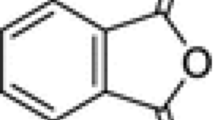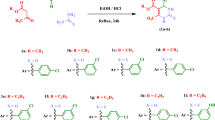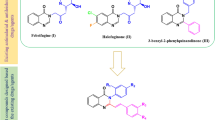Abstract
Novel thiazole, pyrimidine and benzylidene derivatives derived from quinazoline scaffold have been synthesized. The antitumor evaluation of the newly synthesized products against three cancer cell lines namely breast adenocarcinoma (MCF-7), non-small cell lung cancer (NCI-H460), and CNS cancer (SF-268) showed that the benzylidene–quinazoline derivative 12a showed remarkable activity against all three cell lines. The thiazolo-quinazoline derivative 10 showed greater activity than the control against breast adenocarcinoma (MCF-7) with a concentration of 0.01 μM. Moreover, the antileishmanial activity of the newly synthesized products tested on Leishmania donovani amastigotes showed that compounds 4, 14, and 18 had very promising activity.








Similar content being viewed by others
References
Alagarsamy V, Rajasolomon V, Meena R, Ramse-shu VK (2005) Synthesis, analgesic, anti-inflammatory and antibacterial activities of some novel 2-butyl-3-substituted quinazolin-4-(3H)-ones. Biol Pharm Bull 28:1091–1094
Burris HA, Hurwitz HI, Dees EC, Dowlati A, Blackwell KL, Neil BO, Marcom PK, Ellis MJ, Overmoyer B, Jones SF, Harris JL, Smith DA, Koch KM, Stead A, Mangum S, Spector NL (2005) Phase I safety, pharmacokinetics, and clinical activity study of lapatinib (GW572016), a reversible dual inhibitor of epidermal growth factor receptor tyrosine kinases, in heavily pretreated patients with metastatic carcinomas. J Clin Oncol 23:5305–5313
Capdeville R, Buchdunger E, Zimmermann AJ, Matter A (2002) (STI571, imatinib), a rationally developed, targeted anticancer drug. Nat Rev Drug Discov 1:493–502
Daidone G, Maggio B, Raffa D, Plescia S, Bajardi ML, Caruso A, Cutauli VMC, Amico Roxas M (1994) Synthesis and pharmacological study of ethyl-1-methyl-5-[2-substituted-4-oxo-3-(4H)-quinazolinyl]-1H-pyrazole-4-acetates. Eur J Med Chem 29:707–711
El-Azab AS, Al-Omar MA, Abdel-Aziz AA, Abdel-Aziz NA, El-Sayed MA, Aleisa MM, Sayed Ahmed SG, Abdel-Hamid SG (2010) Design, synthesis and biological evaluation of novel quinazoline derivatives as potential antitumor agents: molecular docking study. Eur J Med Chem 45:4188–4198
El-Subbagh HI, El-Naggar WA, Badria FA (1994) Synthesis and biological testing of 2,4-disubstituted thiazole derivatives as potential antitumor antibiotics. Med Chem Res 3:503–516
Fabbro D et al (2002) Protein kinases as targets for anticancer agents: from inhibitors to useful drugs. Pharmacol Ther 93:79–98
Farag AM, Mayhoub AS, Barakat SE, Bayomi AH (2008) Regioselective synthesis and antitumor screening of some novel N-phenylpyrazole derivatives. Bioorg Med Chem 16:881–889
Fry DW, Kraker AJ, McMichael A, Ambroso LA, Nelson JM, Leopold WR, Connors RW, Bridges AJ (1994) A specific inhibitor of epidermal growth factor receptor tyrosine kinase. Science 265:1093–1095
Gilbert IH (2002) Inhibitors of dihydrofolate reductase in Leishmania and trypanosomes. Biochem Biophys Acta 1587:249–257
Gosh D, Chakraborty P (2002) Involvement of protein tyrosine kinases and phosphatases in uptake and intracellular replication of virulent and avirulent Leishmania donovani Promastigotes in mouse macrophage cells. Biosci Rep 22:395–406
Halgren TA (1996) Merck molecular force field: I. Basis, form, scope, parameterization and performance of MMFF94. J Comput Chem 17:490–519
Hassanzadeh F, Jafari E, Hakimelahi GH, Rahmani Khajouei M, Jalali M, Khodarahmi GA (2012) Antibacterial, antifungal and cytotoxic evaluation of some new quinazolinone derivatives. RPS 7:87–94
Hennequin L, Stokes ES, Thomas AP, Johnstone C, Plé PA, Ogilvie DJ, Dukes M, Wedge SR, Kendrew J, Curwen JO (2002) Novel 4-anilinoquinazolines with C-7 basic side chains: design and structure activity relationship of a series of potent, orally active, VEGF receptor tyrosine kinase inhibitors. J Med Chem 45:1300–1312
Khabnadideh S, Pez D, Musso M, Brun R, Pérez LMR, González D, Pacanowska, Gilbert IH (2005) Design, synthesis and evaluation of 2,4-diaminoquinazolines as inhibitors of trypanosomal and leishmanial dihydrofolate reductase. Bioorg Med Chem 13:2637–2649
Kornet MJ, Varia T, Beaven W (1983) Synthesis and anticonvulsant activity of 3-amino-4(3H)-quinazolinones. J Het Chem 20:1553–1555
Kostova I (2005) Synthetic and natural coumarins as cytotoxic agents. Curr Med Chem Anticancer Agents 5:29–46
Lipinski A, Lombardo F, Dominy FW, Feeney PJ (2001) Experimental and computational approaches to estimate solubility and permeability in drug discovery and development settings. Adv Drug Delivery Rev 46:3–26
Madari H, Panda D, Wilson L, Jacobs RS (2003) Dicoumarol: a unique microtubule stabilizing natural product that is synergistic with Taxol. Cancer Res 63:1214–1220
Ozaki K, Yamada Y, Oine T, Ishizuka T, Iwasawa Y (1985) Studies on 4(1H)-quinazolinones. 5. Synthesis and antiinflammatory activity of 4(1H)-quinazolinone derivatives. J Med Chem 28:568–576
Palmer BD, Kallmeyer ST, Fry DW, Nelson JM, Showalter HD, Denny WA (1997) Tyrosine kinase inhibitors. 11. Soluble analogs of quinolo-and pyrazoloquinazolines as epidermal growth factor receptors: synthesis, biological evaluation and modeling of the mode of binding. J Med Chem 40:1519–1529
Rewcastle GW, Denny WA, Bridges AJ, Zhou H, Cody DR, McMichael A, Fry DW (1995) Tyrosine kinase inhibitors. 5. Synthesis and structure-activity relationships for 4-[(phenylmethyl)amino]- and 4-(phenylamino)quinazolines as potent adenosine 5′-triphosphate binding site inhibitors of the tyrosine kinase domain of the epidermal growth factor receptor. J Med Chem 38:3482–3487
Schnur RC, Gallaschun RJ, Singleton DH (1991) Quantitative structure-activity relationships of antitumor guanidinothiazolecarboxamides with survival enhancement for therapy in the 3LL Lewis lung carcinoma model. J Med Chem 34:1975–1982
Sordella R, Bell DW, Haber DA, Settleman (2004) Gefitinib-sensitizing EGFR mutations in lung cancer activate anti-apoptotic pathways. J Science 305:1163–1167
Stamos J, Sliwkowski MX, Eigenbrot C (2002) Structure of the epidermal growth factor receptor kinase domain alone and in complex with a 4-anilinoquinazoline inhibitor. J Biol Chem 277:46265–46272
Toledo-Sherman L, Deretey E, Slon-Usakiewicz JJ, Dai JR, Foster JE, Redden PR, Uger MD, Liao LC, Pasternak A, Reid N (2005) Frontal affinity chromatography with MS detection of EphB2 tyrosine kinase receptor. 2. Identification of small-molecule inhibitors via coupling with virtual screening. J Med Chem 48:3221–3230
Wood ER, Truesdale AT, McDonald OB, Yuan D, Hassell A, Dickerson SH, Ellis B, Pennisi C, Horne E, Lackey K, Alligood KJ, Rusnak DW, Gilmer TM, Shewchuk L (2004) A unique structure for epidermal growth factor receptor bound to GW572016 (Lapatinib): relationships among protein conformation, inhibitor off-rate, and receptor activity in tumor cells. Cancer Res 64:6652–6659
Wright SW, Hageman DL, McClure LD, Carlo AA, Treadway JL, Mathiowetz AM, Withka JM, Bauer PH (2001) Allosteric inhibition of fructose-1,6-bisphosphatase by anilinoquinazolines. Bio Med Chem Lett 11:17–21
Xia Y, Dong ZW, Zhao BX, Ge X, Meng N, Shin DS, Miao JY (2007) Synthesis and structure–activity relationships of novel 1-arylmethyl-3-aryl-1H-pyrazole-5-carbohydrazide derivatives as potential agents against A549 lung cancer cells. Bioorg Med Chem 15:6893–6899
Xu Z, Zhang Y, Fu H, Zhong H, Hong K, Zhu W (2011) Antifungal quinazolinones from marine-derived Bacillus cereus and their preparation. Bioorg Med Chem Lett 21:4005–4007
Zhang H, Berezov A, Wang Q, Zhang G, Drebin J, Murali R, Greene MI (2007) ErbB receptors: from oncogenes to targeted cancer therapies. J Clin Invest 117:2051–2058
Acknowledgments
The authors would like to extend their gratitude to the American University in Cairo for its continuous support through funding this research project.
Author information
Authors and Affiliations
Corresponding author
Rights and permissions
About this article
Cite this article
Fleita, D.H., Mohareb, R.M. & Sakka, O.K. Antitumor and antileishmanial evaluation of novel heterocycles derived from quinazoline scaffold: a molecular modeling approach. Med Chem Res 22, 2207–2221 (2013). https://doi.org/10.1007/s00044-012-0213-9
Received:
Accepted:
Published:
Issue Date:
DOI: https://doi.org/10.1007/s00044-012-0213-9




